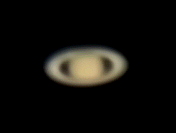SkyTracker Pro & 600mm Lens: Jupiter, Saturn, Moon;
iPhone: Jupiter, Saturn, Moon
Posted: 11 June 2017
Clouds returned on Saturday, 10 June 2017, but the sky mostly cleared as sunset approached. I went to the observatory a few minutes after sunset.
|
Open: Saturday, 10 June 2017, 1937 MST Temperature: 90°F |
Session: 1121 Conditions: Mostly clear |
Equipment Used:
12" f/8 LX600 w/StarLock
2" 24mm UWA eyepiece
2" 9mm 100° eyepiece
1.25" 15mm eyepiece
2" 2X PowerMate
2" 30mm eyepiece
SkyTracker Pro
Camera:
D7200 DSLR
iPhone 6s Plus
1945 MST: LX600 ON, StarLock OFF, High Precision OFF.
1947 MST: began viewing Jupiter. Two moons were visible, 102X. Callisto was well off to the side with Io about to begin a transit of the planet. Switched to 271X. Ganymede in transit was visible near the central meridian. 1956 MST: Io transit began.
Next, I mounted the D7200 DSLR + 150-600mm lens on the SkyTracker Pro and did an approximate polar alignment.
2009 MST: returned to the 12" telescope. Io was still visible in transit, 271X, but was getting more difficult to see against the bright planet. It was neat to see both Ganymede and Io in transit across Jupiter. 2025 MST: Io was no longer visible. 2029 MST: Ganymede was no longer visible against the bright planet. 2029 MST: neither moon was visible, 102X.
I then did some checks of Messier Catalog objects I plan to image on upcoming sessions. Observed the globular clusters M14 and M56, 102X.
2042 MST: the eastern sky was beginning to brighten from the rising waning gibbous Moon.
Resumed viewing Jupiter, 102X and 271X. Seeing had worsened. Neither moon in transit were visible.
2048 MST: Saturn was rising over the hill to the southeast. 2056 MST: strong breezes began.
2057 MST: Ganymede was now visible near Jupiter's limb, 271X. 2102 MST: Ganymede transit ended. 2118 MST: the shadow of the moon Io was now transiting the planet. The Great Red Spot was rotating into view.
2123 MST: began preparing the SkyTracker Pro for imaging:

First, imaged the planet Jupiter, f/6.3, ISO 400, FL 600mm. The full-frame image shows the scale. The two insets show magnified images of Jupiter. The top inset (1/60sec) shows Jupiter with the moon Io faintly visible at 1 o'clock. The bottom inset (1/400sec) shows Jupiter and Io's shadow at the left limb.

This next image shows Saturn, f/6.3, 1/125sec, ISO 400, FL 600mm:

Pointed the DSLR at the Moon and set the SkyTracker Pro to Lunar Tracking Rate. This is a full-frame f/11, 1/640sec, ISO 400, FL 600mm, image:

2207 MST: ended imaging using the DSLR and SkyTracker Pro. Although using the SkyTracker Pro was not absolutely necessary to image the planets and the Moon as I was using very short exposures, it certainly helped by keeping the objects in the camera field-of-view with the long focal length I was using.
2210 MST: returned to the 12" telescope and viewed Jupiter, 271X. The transit of the moon Io was over but its shadow was still visible. Switched to the 15mm eyepiece + 2X PowerMate (325X) and mounted the iPhone 6s Plus using the Levenhuk adapter. Using the iOS Camera app did some slo-mo (240 fps) video recordings of Jupiter and Saturn. This image of Jupiter is a stack of 2495 video frames, afocal 325X:

Io's shadow is visible on the Northern Equatorial Belt, just to the left of the central meridian. The Great Red Spot is visible in the Southern Equatorial Belt, just to the right of the central meridian.
Seeing was not good when I was imaging Saturn. This is a stack of 2489 video frames, afocal 325X:

This is how Saturn appeared live on the Apple Watch using the iOS app NightCap Camera:

2238 MST: viewed the Moon, 102X and 81X. Took this handheld iPhone photo of the Moon, afocal 81X, using the Camera app:

2247 MST: LX600 OFF. Three Kissing Bugs were terminated this night.
|
Close: Saturday, 10 June 2017, 2300 MST Temperature: 73°F |
Session Length: 3h 23m Conditions: Clear, breezy |
Comments are welcome using Email. Twitter users can use the button below to tweet this report to your followers. Thanks.
Cassiopeia Observatory Home Page
Copyright ©2017 Michael L. Weasner / mweasner@me.com
URL = http://www.weasner.com/co/Reports/2017/06/11/index.html
